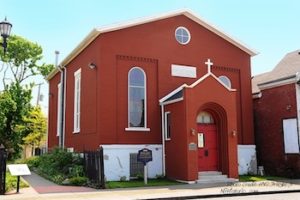
Michigan Street Baptist Church
The Michigan Street Baptist Church was founded on this date in 1837 in Buffalo, NY, and is one of the oldest Black Baptist Churches in the United States.
The congregation was formally organized between 1832 and 1837. During that time, Charles B. Ray, a traveling agent for the Colored American Weekly newspaper, filed a written report describing Buffalo's Black community. “The Colored community of Buffalo is, in many respects, above any community of our people I have visited during my western tour. They have among them two religious societies, one benevolent, and three literary societies. The males spend their winter evenings debating moral and political questions. Their school is, for the present, discontinued for want of a teacher. Their children are in attendance at the white private schools.”
Around 1908, a historical sketch of the church was written by Dr. J. Edward Nash, the church's pastor at the time. In it, he states, "During the ministry of Elisha Tucker, Pastor of the Washington Street Baptist Church, a council was called to organize a colored Baptist Church, to be constituted of members from the Washington Street Church." This church was the first Baptist church to be established in Buffalo. It was a white congregation that allowed blacks to worship in the facility. Tucker initially conceived of organizing a Baptist congregation for Blacks in 1836.
One year later, 13 Black congregants gave letters of dismissal and began building their congregation. They organized the first Black Church of any denomination in the city. With very little money, the congregation worshipped in a rented room above an undertaker on Eagle at Niagara for their first seven years. In the early 1840s, under the leadership of Pastor Rev. Sharpe, plans were made and a suitable house of worship was purchased on Michigan Street. But with no money available to construct a church, Rev. Sharpe traveled to England to raise money, finding little success.
By 1844, under the fifth pastor, the Rev. Samuel H. Davis, enough money had been raised that the congregation began building their house of worship. A mason by trade, the Rev. Davis performed most of the construction work himself. In June 1845, the cornerstone of the church was placed. Four years later, the building at 511 Michigan Avenue was ready for worship. The congregation flourished until the California Gold Rush of 1849, when many prominent members left to seek their fortunes.
The congregation remained optimistic, and later, the building served as a stop on the Underground Railroad in the years leading up to the American Civil War. Fugitive slaves were hidden in the church's basement before being ferried across the Niagara River to Canada at night. As the number of northern Black communities increased, so did the number of churches and other agencies serving these communities. In time, different churches and community agencies began to assume some of the functions that the Michigan Street Baptist Church had performed for over a century.
The congregation celebrated its final church service on February 24, 1962. The following week, its members began holding regular services in the former Humboldt Parkway Methodist Church, which has always been the home of a Baptist congregation.
Although the Michigan Street Church has relinquished its center stage in community life, its place in the 19th and early 20th-century history of Buffalo's African American community is celebrated and memorialized by future generations. The Michigan Street Preservation Corporation works to restore and preserve the site as a community landmark. The Michigan Street Baptist Church building was placed on the National Register of Historic Places in 1974.